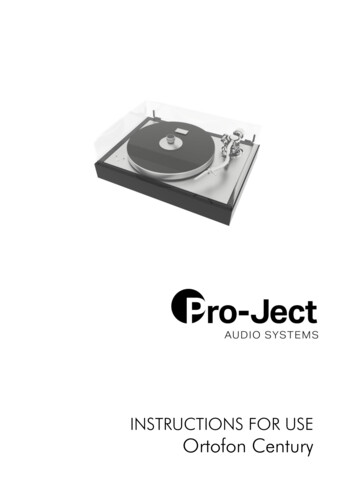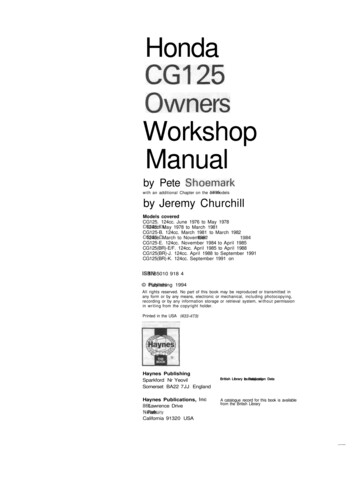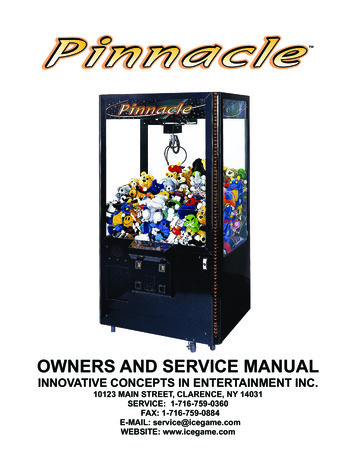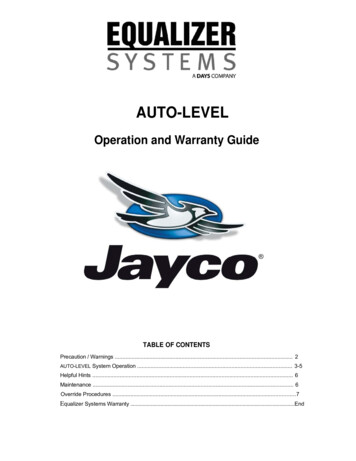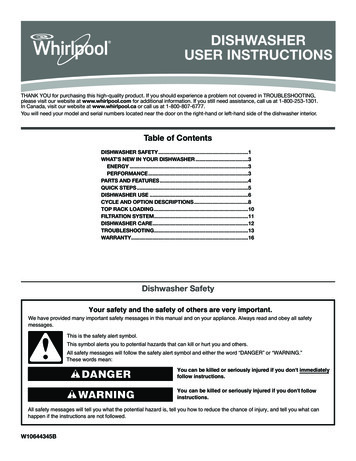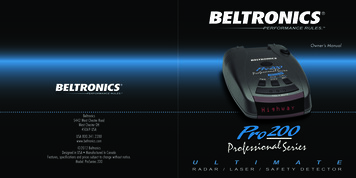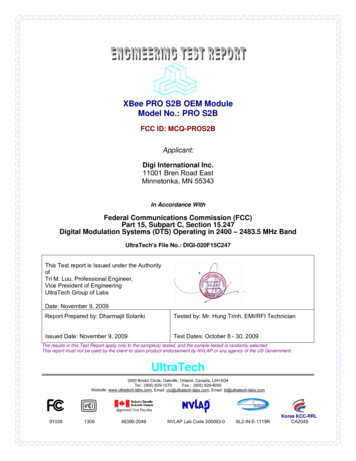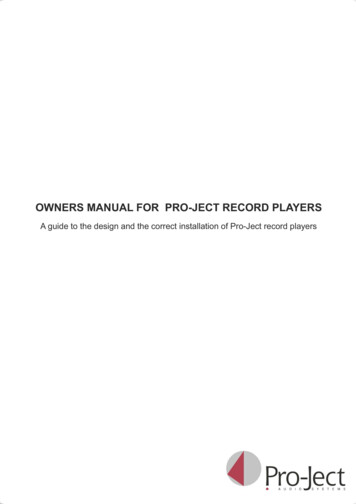
Transcription
OWNERS MANUAL FOR PRO-JECT RECORD PLAYERSA guide to the design and the correct installation of Pro-Ject record players
ContentsThe Design Principles behind Pro-Ject record playerspage.3The Turntable and Motor Systempage.3, 4The importance of setting the turntable levelpage.5The Tone-Armpage.6Vertical Tracking Angle, the Initial Adjustmentpage.7The Azimuth Adjustmentpage.7The Lateral Tracking Errorpage.8, 9The Down-Force or Tracking Weight and Bias Compensationpage.10The Fine Adjustment of the Vertical Tracking Anglepage.11Aligning the Tone Arm and Cartridgepage.12, 13Fitting a new Cartridge to the Tone Armpage.14Adjusting the Lateral Tracking Errorpage.15Making the Connections and Speed Changepage.16, 17Service and Packingpage.18Page.2
The Design Principles behind Pro-Ject record playersBefore a record player can be designed, some important principles must be understood. The mostimportant of these is that the stylus or diamond tip of the cartridge must exactly trace theundulations pressed into the groove walls of the record. For this to happen the pickup cartridgemust be held absolutely rigid and stable, and the record must also be held absolutely rigid andstable. Then the only thing that is moving is the diamond tip, and as a result the output of thecartridge is a perfect electrical replica of the shape of the groove with nothing added and nothingtaken away.That is the theory. In practice the record is being rotated and so cannot be held rigid and thecartridge is mounted in a freely moving tone-arm, which also cannot be held totally rigid.None the less the skill of the designer is to rotate the turntable at a constant speed whilst allowingit to have no lateral (side-to-side) motion and to design a totally rigid tone arm which allows thestylus to track across the record. The success of the designer in getting close to these idealsdetermines the ultimate performance and the quality of the musical experience.But there is more. The designer may do a superb job, but he needs to be backed up by a factorythat is capable of manufacturing components to very close mechanical accuracy and tolerancesthen assembling them with care before aligning them to absolute standards.Over the next few pages we’ll take a look at some of the essentials of record player design, andhow Pro-Ject has created its outstanding turntable products.The Turntable and Motor SystemAt first glance it would seem to be a simple task to rotate a turntable at the correct speed, but inpractice there are a number of problems which can be difficult to overcome. The turntable platteris mounted onto a shaft which rotates upon a bearing assembly. First these bearings have to beextremely smooth in operation because any irregularities produce 'rumble', the effect of which issimilar to that felt when driving a car along a gravel path. The small undulations cause the platterto move up and down an almost imperceptible amount but the movement is detected by the stylusand added to the signal as a distortion.Secondly the bearing has to be very tight with virtually no slack, which would allow the shaft andplatter to move from side to side. Again any sideways motion would be detected by the stylus as a'wow'; the sort of effect that would be heard on a sustained piano note as a crude vibrato.For much the same reason the turntable platter itself needs to be perfectly balanced and be ofuniform structure. The Pro-Ject acrylic platters are particularly good in this respect. Obviously therotational speed needs to be held constant and this is normally achieved using an ACsynchronous motor which is locked to the mains supply frequency. (Close to absolute stability canbe obtained by using a crystal-controlled supply such as the Pro-Ject Speed Box). Of course eventhe best motors have imperfections, and these include the small vibrations created within themotor bearings; small vibrations caused by noise and interference on the mains power lines andthe so-called 'clogging' vibrations; a consequence of the motors having a finite number of polesgiving an 'on-off-on-off' type of motion.Page.3
The Turntable and Motor System (continued)Any of these vibrations reaching the stylus could degrade the sound, so it is good design practiceto de-couple the motor assembly from the turntable platter by a belt drive using a carefullyspecified belt. The characteristics of this belt (compliance, surface finish, etc.) and the amount oftension determine the degree of isolation between the motor and platter, but a high-mass platterwill always smooth out any tiny remaining speed irregularities as a result of the 'flywheel effect'which causes the rotational speed to settle to a constant value.Almost every object resonates at some or otherfrequency. Tap any object and the “knocking”sound will be at a different note from object toobject, because each has its dominantresonances. When an object resonates it actuallyvibrates to a larger than usual degree and, ofcourse, in a record player any vibrations have therisk of being picked up by the stylus and added tothe music signal. For this reason the turntableplatters used by Pro-Ject are made fromextremely well-damped materials, such as acrylic,which have no significant resonances within theaudio frequency band; and so avoid adding anycolourations to the sound.The Tone-ArmThe design of a tone-arm is a demanding task. Earlier we said that a key design requirement isthat everything be held absolutely rigid and stable. If a tone-arm has any flexibility between itspivot point and the stylus then any movements will be superimposed on top of the music signal,causing it to be degraded. In practice this means that the whole assembly should ideally be ahomogeneous single piece which is rigid and free from flexing. Yet at the same time this armneeds to have a low-mass in order to work well with most modern pick-up cartridges.Pro-Ject has met this requirement superbly on most of its turntables by using a carbon fibre tube,which is one piece from pivot to the cartridge mounting platform. In addition to being one piece,the carbon fibre arms are almost completely free from flexing, by virtue of the fibre alignment, andthrough their conical tube shape have a high order of rigidity and a freedom from the 'tuberesonance', which can degrade the performance of conventional arm-tubes.Page.4
The Steps taken to Align a Record PlayerThe importance of setting the turntable levelOne of the first steps in setting up any record player is the need to ensure that the turntableassembly is perfectly level. This is because the overall performance and all the other adjustmentshave been calculated from the datum or reference point of a perfectly level record platter. If theturntable is tilted to one side then the force of gravity will not be acting vertically but will be applyinga force in the direction of the tilt. The effects of this force can be quite insidious and very audible.One audible effect can be an increase in the wow & flutter. These are respectively the slow andquick cyclical changes in speed as the platter rotates, and even if these changes are small they willbe audible particularly on piano music. The force due to gravity will also effect how the stylus tracksthe record groove because with a sloping record surface the stylus will try to run down the slope,causing it to press harder on one groove wall than the other.There are also other potential problems. Suspended turntables are designed to work in the verticalplane with a resonance or natural frequency tuned well below any audio frequency. If the platterdoes not “bounce” with a pistonic action only in the vertical plane then there will be othersecondary motions some of which will be in the audible frequency range.Obviously these suspension problems are avoided with non-suspended turntables, but there willstill be a degrading effect upon the main bearing which should have minimal rotational friction andhold the platter in a fixed position in all planes with minimal play and as little vibration as possible.All such bearings are designed to work with the turntable level so that all the forces are actingvertically downwards. Tilt the table and you add a horizontal force which will compromiseperformance and over the long term cause the bearing to wear unevenly.Before leveling the record player the supporting table, cabinet or shelf should be made as level aspossible because any leveling made on the record player is designed to be a fine adjustment tobring it to a near perfectly level position. If the supporting surface is seriously out of level it may bea good idea to use one the adjustable tables which your hi-fi dealer can provide as an accessory.The spirit level should also be positioned in a number of locations because the turntable needs tobe level in both planes; both front-to-back and side-to-side.Page.5
The Tone-ArmThe design of a tone-arm is a very demanding task. Earlier we said that a key design requirementis that everything be held absolutely rigid and stable. Because if a tone-arm has any flexibilitybetween its pivot-point and the stylus then any movements will be superimposed on top of themusic signal causing it to be degraded; the sound becomes muddled and “out of focus”. In practicethis means that the whole assembly should ideally be a homogeneous single-piece, which is rigidand totally free from flexing. Yet at the same time this arm needs to have a low-mass in order towork well with most modern pickup cartridges.Pro-Ject has met this demanding requirement superbly by using a carbon fibre tube which isformed in one piece from pivot to the cartridge mounting platform. It has, by virtue of the fibrealignment, an almost complete freedom from flexing; and gains, through its conical tube shape, ahigh order of rigidity and a freedom from the 'tube resonance' which can degrade the performanceof many conventional arm-tubes.The ideal record playing system works within a mechanical closed loop. So the turntable platter isrigidly coupled to the chassis or sub-chassis, so when the chassis moves up or down so does theplatter. The arm mounting pillar should be rigidly coupled to the chassis; the arm tube should be'rigidly' coupled to the mounting and the cartridge should be rigidly mounted to the arm-tube. Inthis way if one component moves all the linked components move so there is no relativedisturbance between the stylus-record contact. Pro-Ject gets close to this ideal by using 'virtuallyzero-play' bearings for the arm-tube mounting, which allow free movement of the arm in thevertical and horizontal planes but absolutely no movement at the arm pivot point.Setting up the Tone Arm and Cartridge to give the best performanceOver the next few pages we’ll explain why the tone arm needs to be adjusted in order to perfectlytrace the groove of the vinyl record. When the record player is provided with a pre-fitted cartridgethen there are only two adjustments required and they are simple to perform. However, when anew cartridge is fitted then either you or your hi-fi dealer will need to perform a series ofadjustments. Full details of these adjustments and how to perform them are given in the nextsection.Page.6
Vertical Tracking Angle, the Initial AdjustmentWhen an original record master is cut the cutter sits at a slight angle to the record surface,because the cutter head needs to be lifted slightly above the record surface. This angle iscalled the Vertical Tracking Angle (VTA) and can vary from record to record. In the 1960smost records were cut with a VTA of 15 degrees, but by the 1980s the standard became 20degrees. Yet even though there are standards, many successful cutting engineers stillmake their own choice of VTA as well, in order to give the sound the particular characterwhich is their trademark.If your record player is delivered with a fitted tone-arm and pickup cartridge then the correct VTAwill have been set by the factory and no further adjustment is needed. However, if the tone-arm orcartridge are changed then the VTA will need to be set and this is done in two steps. The firstsimple step is to check whether the arm and the head-shell are parallel to the record. Mostmanufacturers of cartridges mount the stylus cantilever so that a Vertical Tracking Angle of about20 degrees is achieved when the arm is parallel to the record. If the arm is not parallel to therecord you should loosen the locking collar on the base-board (as shown in the next section of thismanual) and then carefully move the arm up or down until the arm tube is parallel to the surface ofthe record.VTA20 degThe Azimuth AdjustmentBecause the music is recorded into the two walls of a 'V' shaped record groove, it is obviouslyessential that the stylus of the pickup cartridge sits perfectly vertical in the groove - rather thanleaning into one or other of the walls. This adjustment is called the Azimuth Adjustment and can bechecked by viewing the position of the stylus diamond tip in the record groove. Another easiermethod is to put a small mirror on the record disk in front of under the stylus whilst viewing thecartridge from the front. When the alignment is correct the cartridge and its reflection will beperfectly in line with each other (as shown in the drawing below). Adjustment instructions will bedetailed shortly.The cartridge viewed from the frontThe small mirror on the vinyl surfaceThe reflection of the cartridgePage.7
For the more experienced listener there is another very accurate method of adjusting the azimuth.Simply swap one pair of the cartridge wires around (effectively reversing the polarity of onechannel) then switch the amplifier to mono (or use a “Y” cable adapter to turn the stereo signal intoa single mono signal).OutputSignalPickup CartridgeInputSignalsAmplifierLoudspeakerAzimuth Not Correctly AdjustedOutputSignalPickup CartridgeInputSignalsAmplifierLoudspeakerAzimuth Correctly AdjustedThen play a track on a mono recording (availa
turntable is tilted to one side then the force of gravity will not be acting vertically but will be applying a force in the direction of the tilt. The effects of this force can be quite insidious and very audible. One audible effect can be an increase in the wow & flutter. These are respectively the slow and quick cyclical changes in speed as the platter rotates, and even if these changes are .

